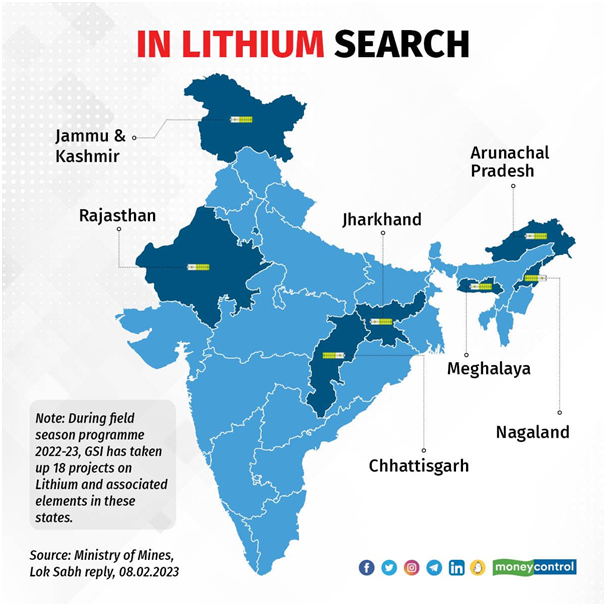

|
About lithium (Properties)
|
Context
Though the recent discovery of 5.9 million tonnes inferred resources of lithium in Jammu & Kashmir, by the Geological Survey of India is a game-changer in India’s impending transition to a green economy. However, the development of these reserves needs to be conducted sustainably – both in terms of the environment and equity
About
Why is the finding a big deal?
- Usage: The soft, shiny gray metal is an extremely important one in today’s world. It is used, among other things, to build the batteries that electric vehicles cannot do without. Hence the name ‘white gold’.
- Self-reliance in the LIB [lithium-ion battery]: If India has its own sources of lithium, it would not have to rely too much on imports for its lithium needs, as it currently does.
- In 2020-21, India importedRs 173 crore worth of lithium and Rs 8,811 crore worth of lithium ions. India’s lithium needs are also likely to rise, given the push for electric vehicles.
- Rare: Lithium reserves are also rare.
- There are 98 million tonnes of lithium globally, said Rishabh Jain, senior programme lead, Council on Energy, Environment and Water (CEEW). Now India has found 5.5% of these resources
|
As per one estimate, Chile – at 9.2 million tonnes – led the world in lithium reserves, followed by Australia (6.2 million tonnes). So India’s recent find of 5.9 million tonnes of lithium could catapult it into the top three countries in the world with the highest lithium reserves. |
How critical is lithium for India?
- The lithium deposits are critical for India as the country puts its focus on electric mobility for both public and private transport, especially in the country's prime cities such as New Delhi, Mumbai, Bangalore, Kolkata, and Chennai.
- These metals are strategic in nature and have a wide range of applications in nuclear and other high-tech industries, including electronics, telecommunications, information technology, space, and military.
- India's Ministry of Mines further stated that 51 mineral blocks including Lithium and Gold were handed over to respective state governments.
- Out of the 51 mineral blocks, 5 blocks are of gold.
- Other blocks pertain to commodities like potash, molybdenum, and base metals.
India’s lithium reserves
- According to the Indian Mines Ministry, the government agencies made small discovery of lithium resource at a site in Mandya, Karnataka. It is the country’s first lithium reserve.
- Now, Lithium inferred resources has been found in Reasi District of Jammu & Kashmir (UT).

Lithium Production in the world
- According to the US Geological Survey (USGS), global lithium production in 2019 stood at 77,000 tonnes.
- Australia, Chile, China and Argentina are the world’s top four lithium-producing countries.
- Australia is by far the world’s top producer of lithium, with an output of 42,000 tonnes in 2019.
What is the Lithium Triangle?
- The Lithium Triangle is a region of the Andes rich in lithium reserves around the borders of Argentina, Bolivia and Chile.
- The lithium in the triangle is concentrated in various salt pans that exist along the Atacama Desert and neighboring arid areas.
- The area is thought to hold around 54% of the world's lithium reserves.
- The Indian Navy has shown interest in the Lithium Triangle as lithium will be required on Li-ION batteries that are planned to be fitted in future submarines.
|
About Geological Survey of India (GSI)
|
Impact on Environment
- Water-intensive: The process of extracting lithium from its ore is also extremely water-intensive; as per one estimate, it takes approximately 2.2 million litres of water to produce one ton of lithium. And the demand for lithium is only increasing.
- Extensive mining:Extracting Li from hard rock mines entails open-pit-mining followed by roasting the ore using fossil fuels.


